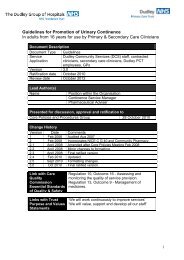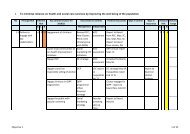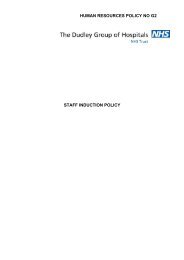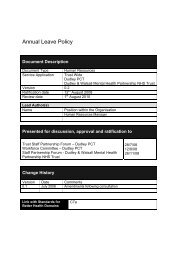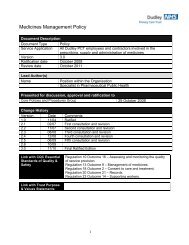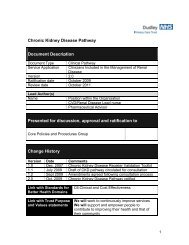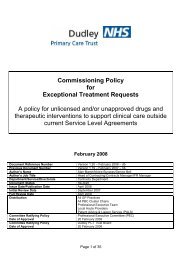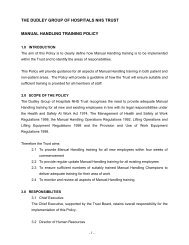Dudley Strategy for Tackling Health Inequalities 2010-15
Dudley Strategy for Tackling Health Inequalities 2010-15
Dudley Strategy for Tackling Health Inequalities 2010-15
- No tags were found...
You also want an ePaper? Increase the reach of your titles
YUMPU automatically turns print PDFs into web optimized ePapers that Google loves.
Ensure that data systems <strong>for</strong> tracking the impact of economic strategyinitiatives use a consistent approach to assessment across the socialgradient.Ensure that public and private sector employers adhere to equality guidanceand legislation.Develop means of implementing guidance on stress management and theeffective promotion of wellbeing and physical and mental health at work, both<strong>for</strong> public sector and private sector employees.Consider the potential <strong>for</strong> incentivising employers to adapt jobs to providesuitable employment <strong>for</strong> lone parents, carers and people with physical /mentalhealth problems.Ensure that <strong>Dudley</strong> participates to the maximum in any available wellevidenced active labour market programmes.A HEALTHY STANDARD OF LIVING FOR ALLA <strong>Health</strong>y Standard of Living <strong>for</strong> All: What does the Evidence Tell Us?Marmot‟s review shows that both income and wealth have an effect on healthinequalities. People on low income do not buy goods and services that maintain andimprove their health and often have to purchase cheaper goods and services thatmay increase their risk of ill health. Low income can also mean that people do notparticipate in ordinary social and community life, leaving them with low self esteemor feelings of being less worthy. There is also a psycho-social adverse effectderiving from perceived position in the social hierarchy. Further evidence shows thatthe degree of inequality in income in society affects not only the poor, but society asa whole. Countries with marked income inequality have worse health and higherrates of crime and other adverse social outcomes. In high income countries, theevidence suggests that more generous social protection (benefit) systems lead tobetter population health outcomes and increased life expectancy.In the UK income inequality rose rapidly between 1984 and 1990. Since theninequality in equivalised disposable income remained constant till approximately2001, when it began to fall. The fall halted in 2004/05 and inequality in equivaliseddisposable income remained at a steady level from then until 2007/08.Data from ONS presented in the Marmot Report (<strong>2010</strong>) shows that In 2007/08 thetop fifth of all households earned 16 times more than the bottom fifth. Transferpayments (cash benefits paid through the welfare system) mitigated thisconsiderably so that once these are taken into account; the top fifth of all householdsearned 7 times the lowest fifth. However, the UK tax system is overall regressive(given the high proportion of taxation taken as indirect taxes), which means that <strong>for</strong>final disposable income the top fifth of all households have 6 times the bottom fifth.It can be seen from these figures that the mitigation of income inequality is mainly41




